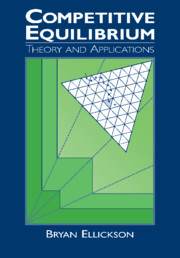8 - What is competition?
Published online by Cambridge University Press: 04 December 2009
Summary
We have learned that Walrasian equilibrium exists in a wide variety of circumstances. But establishing existence only partially validates the competitive hypothesis. The Edgeworth box notwithstanding, markets with two consumers are unlikely to be competitive. How then do we recognize settings in which the Walrasian model is appropriate, where price taking is the right thing to do? This is the question which this final chapter tries to address.
We cover a lot of ground. The chapter begins with a diversion, a proof of the Second Fundamental Theorem of welfare economics. Apart from its intrinsic interest, this theorem provides some useful background for material presented later. The second section addresses our major question in terms of core equivalence and core convergence. The third section looks at the issue of competition from another point of view, examining Walrasian equilibrium when the number of commodities is not finite. As I argue in the final section, allowing for a double infinity of consumers and commodities — the large square economy — provides the right setting for addressing the question: What is competition?
The Second Fundamental Theorem
All Walrasian equilibria are efficient. This familiar claim does not offer much solace to a starving person. The Second Fundamental Theorem of welfare economics is meant to put a kinder face on competition, suggesting that — with suitable taxes and transfers — the market can be induced to support any Pareto optimal allocation whatsoever. Although rather naive as a statement of social policy, proving the Second Fundamental Theorem is worthwhile nonetheless: not for its social content, but as a useful technical fact about the Walrasian model.
- Type
- Chapter
- Information
- Competitive EquilibriumTheory and Applications, pp. 331 - 374Publisher: Cambridge University PressPrint publication year: 1994



